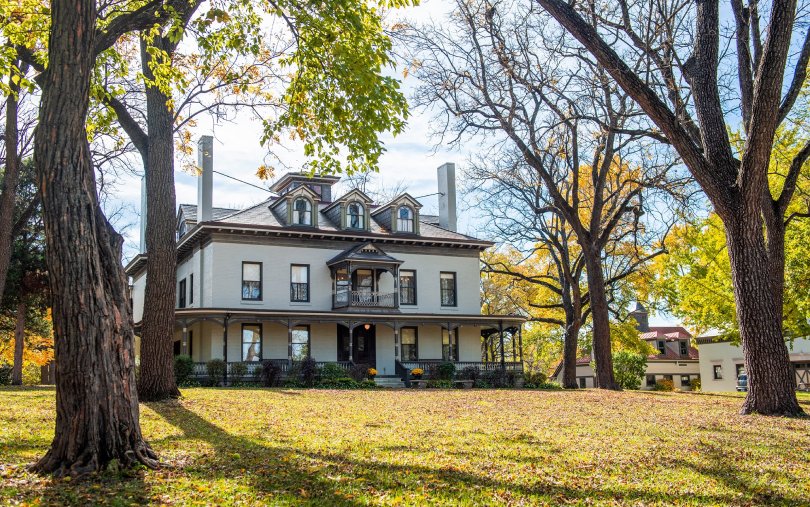History
The Bingham-Waggoner Estate is recognized today as one of the more significant historical sites in Western Missouri because of its role in the history of the area and the people that lived there.
Queen of the Trails
In the early settlement days, before established roads were laid out, the estate grounds were considered a "short-cut" on the road that was later to become part of the "Santa Fe Trail". Because of this high-traffic location the property had many owners between 1827 and 1878. Some hoping to make a living from outfitting the covered wagon trains, others were apparently just real-estate speculators.
During the trails period, thousands of wagons rolled down the hill from the Courthouse Square and passed over the property where the museum now sits. Evidence of the migration can still be seen today in the form of swales, or wagon ruts, left in the field directly across the bridge from the museum.
George Caleb Bingham
George Caleb Bingham, famous 19th century American artist and Missouri politician, was one of the home’s most distinguished residents. He and his family moved to the estate shortly before the outbreak of the Civil War. Bingham maintained a studio at his residence in Independence, a log-and-clapboard building to the northwest of his home. (Thought to be one of the first buildings built by earlier owners.) Bingham used this building as his studio. It was in this studio, Order Number 11 was painted.
The military proclamation officially known as Order Number 11 was issued in Kansas City, Mo. In August 1863, Brig. Gen. Thomas Ewing, Jr. commander of the District of the Border required all persons living in Jackson, Cass, Bates and Vernon counties, excepting only those residing in certain areas near large towns, to leave their homes within fifteen days. The violence manifested itself chiefly in border raids by "Red Legs" and "Jayhawkers" who consistently plundered and committed violent aggressions on Missouri towns. The military order issued by Ewing was intended as a retaliatory measure after a particularly bloody raid was made from the Missouri side by guerrilla William Quantrill and his band on the town of Lawrence, Kansas. Bingham strenuously resented the order and appealed personally to Ewing’s superior officer, Gen John M. Schofield, to have it rescinded, but to no avail. When he was told the order would have to stand, he reportedly warned Schofield, "If God spares my life, with pen and pencil, I will make this order infamous in history." The painting Martial Law, or The War of Desolation, better known as Order Number 11 was the result. There are two versions of the picture. In 1868, he made arrangements with John Sartain of Philadelphia to have "Martial Law" reproduced as an engraving. Upon publication, the engraving caused much furor and was denounced from the pulpit as being too sympathetic to the Confederacy and its cause. In March 1870, Bingham finished his second version of Order Number 11. The second, painted in the spring of 1870 shows minor changes in details and pose and costume. The second version is better known since it was the one used by Sartain to produce the large engraving commissioned by Bingham. It soon became one of the most publicized pictures of the day.
During this period, Bingham also was politically active. In 1868, he became a candidate for Congress from the Sixth Missouri District. He was defeated at the nominating convention.
Bingham sold his home in Independence to Mr. Francis Eames in 1870 and moved to Kansas City. Bingham would fondly remember his home of five years, returning in 1874 to a Fourth of July celebration to deliver a speech about the importance of the day and its relationship to the City of Independence and its citizens.
In Kansas City, Bingham served as Police Commissioner. He then served as Adjutant General of Missouri and investigated the bombing of the James home at Kearney, Missouri, by Pinkerton agents. He later was appointed as the first professor of art at the newly established University of Missouri, an institution championed by his old friend James S. Rollins. Mental incapacity claimed his second wife Eliza, and her condition required her confinement at the state asylum at Fulton, Missouri, where she died on November 3, 1876. Bingham married for the third time, one year before his death. His bride was Mrs. Johnston Lykins, widow of a former mayor of Kansas City and rabid confederate supporter, who established a home for Confederate war widows and orphans, the Lykins Institute, in Kansas City. It was here with Mattle Lykins that Bingham made his home in 1877, and it was here that he died on July 7, 1879, from what papers of the day termed "choleramorbus".
The Waggoners
The Waggoners were early millers in Perry and Cumberland Counties, Pennsylvania. In 1865, Peter Waggoner, Sr. sent his son William to Independence to look over business opportunities. William liked the prospects, and in 1867 the family purchased the "old City mill" from John Overfelt. The family business developed a reputation for producing the very best in baking and cake flours, and "Queen of the Pantry" flours became known all over the middle west.
Reflecting their improved economic condition, the Waggoner's new home across the street from their rapidly growing flour mill immediately began to be adjusted to fit the needs and expectations of its owners. During the 1890's, extensive renovation was done to the home when William Henry, Jr. and his wife moved into the home. They contracted the architectural firm of Root and Siemens, with Mr. Henry Ohaus in charge of interior decoration.
Preserved Today
The Waggoner family continued to live in this home until 1976, when Harry K. Waggoner died. In 1979, a group of private citizens, in cooperation with the City of Independence, purchased the 19.5-acre tract for a museum and public park.
The Bingham-Waggoner Estate stands today as a tribute and a monument to those hundreds of thousands of searching souls who passed by and laid their hands to the task of settling the land and building a nation.








